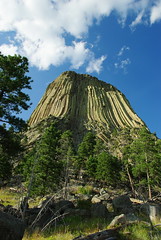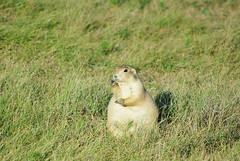Greetings from northeastern Wyoming! Most of you have likely never heard of Newcastle, much like myself when I accepted my internship to work at the Bureau of Land Management for a wildlife biologist. Newcastle lies on an ecotone between sagebrush grassland and the westernmost fringes of the Black Hills. It is a tiny town about 12 miles west of the Wyoming/South Dakota state line, populated largely by coal miners, oil field roustabouts, and oil and gas refinery workers. I never once imagined myself working in a place like this.
Our field office is miniscule. There are a whopping fourteen employees, two of which are currently on detail assignments to other field offices. But don’t take the small stature as an indication of a small amount of land. On the contrary, the twelve people here at the Newcastle BLM are responsible for managing 260,000 acres of public land, spread out across almost 3,125 square miles. Additionally, most of the public land in this part of WY is in tiny parcels, usually only 40 to 200 acres in size, which are typically surrounded by private land with few access roads. Imagine my surprise when I found that I’d often be driving into South Dakota and Montana in order to get onto BLM land in Wyoming!
As you can imagine, resources here are spread thin, so I am on my own in the field. I unfortunately haven’t had the opportunity during my internship to work with others during fieldwork. To say that I am not occasionally terribly lonely would be untruthful, but I’m naturally independent and often find the solitude enjoyable.
I’ve been tasked with a variety of things over the course of my internship. I started off by surveying for northern goshawk in the Black Hills, traversing surprisingly steep hillsides and gorgeous canyons, then followed that up by checking on known raptor nests in cottonwoods growing along drainages to see if they were utilized this season. At various times I’ve deployed a nifty system called Anabat, which records bat echolocative calls. The patterns of the calls can be used to determine the species in an area.
I’ve surveyed prairie dog colonies for burrowing owl and mountain plover (dismayed to find many colonies nearly devoid of dogs… mostly due to
poisoning and hunting, although somewhat as a result of sylvatic plague). And for the past few weeks, I’ve been completing sage-grouse habitat vegetation surveys, much like Nelson and Michelle in Cedar City, UT.
In July, I was fortunate enough to have the opportunity to participate in an environmental education program held by the Newcastle BLM for local middle school students. For three weeks, small groups of students were hosted at a campsite in the Black Hills in South Dakota, and I was in charge of teaching the kids about various wildlife species in the Hills, their habitats, and pertinent conservation issues, all of which mandated hikes in the forest and evening sessions watching bats feed over a pond.
By far, however, my favorite experience has been tracking radio-collared sage-grouse in Thunder Basin National Grassland. We have only four collared grouse, three females and a male, but I go out and find them all at least once a week, every week, and over the last four months they’ve grown to seem like close, familiar friends. (As a tragic side-note, I used to have five collared grouse, with a fourth female, but she was killed last week by a hunter : ( What are the odds, really?)
Radio telemetry isn’t for everyone, as it requires a special brand of patience, but I find it extremely rewarding. It’s always comforting to me to visit one of my bird’s favorite haunts, tune the receiver to the indented frequency, and her the soft, steady pulsing beeps indicating that the grouse is nearby. Even though a couple have frustrated me to no end by taking off at random intervals, travelling miles, and then moving around sporadically week to week (e.g. I “lost” them), I’ve always had the pleasure of sleuthing out where they ended up, triumphantly finding them again, reassured that at least a few members of this potentially-endangered species are still living the way they should be, wild, in the seemingly endless seas of sage in northeastern Wyoming.
Rachel Wheat, BLM, Newcastle, WY



